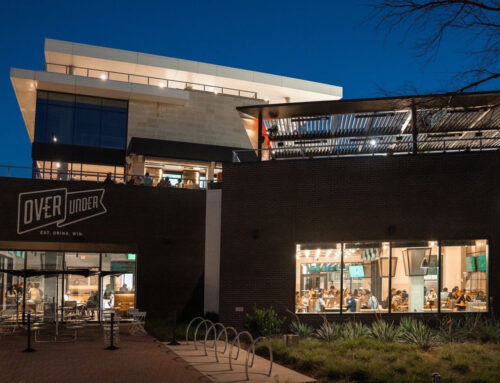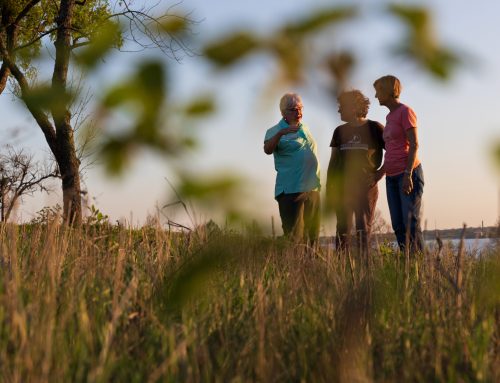They want to offer a lake view to resident seniors, but neighbors opposing development at White Rock Lake are giving C.C. Young officials the big building blues
Neighborhood businessman and city plan commissioner Bill “Bulldog” Cunningham says people concerned about a proposed eight-story building near White Rock Lake have made their opinions clear.
“There have been two basic opinions,” Cunningham says. “No, and hell no.”
Indeed, since word circulated that retirement community C.C. Young has applied for a zoning change allowing a new structure on their 20-acre site off Mockingbird near Lawther, some neighborhood residents have been up in arms.
Their objection? Well, to begin with, the new building would nearly double the present structure’s height, taking it from 45 feet to 85 feet tall, dominating the skyline and obstructing views, protesters say. And, they say, a larger issue is precedent: Build one eight-story building near White Rock Lake, and others are sure to follow.
Some of the objections have come from residents of the Cloisters neighborhood, situated directly across Mockingbird Lane from the C.C. Young campus [the retirement community has been a neighbor since 1960].
Jonathan Hustis, president of Cloisters Homeowners Association, says he can’t believe the project is even being considered.
“Why in world would the city change the zoning for [that site]?” asks Hustis, who says he regularly runs, bikes and kayaks at White Rock. “The lake is unique in Dallas. There is no other place that has that kind of rural atmosphere to it, and it’s really kind of amazing in a city as dynamic and growth-oriented as Dallas has been.”
Hustis and his neighbors are so opposed to the idea that they’ve rallied support from the nearby Brentcove and Lakewood neighborhoods and the White Rock West Condominium Association, in some cases going door-to-door to assert their case.
Many of the letters and e-mails that resulted from those efforts have landed on the desk of Cunningham, who represents District 9 (our neighborhood) on the City Plan Commission, which must address the zoning request before it reaches the City Council.
The issue, he says, is really one of change — change that can’t be hindered forever.
“Look at what’s happened in Chicago or the Atlantic Boardwalk — really any place with water frontage,” Cunningham says. “You’d probably find the same resistance by settlers that were there back in those days, people saying: ‘Never do we want any buildings built here.’
“And now,” he says, “Chicago has nothing except high rise after high rise right there on the waterfront. After a period of time, you’re going to find that places like these are going to be developed. And you’re going to have the same thing on White Rock Lake.”
Still, Cunningham says now might not be the right time for such development.
“I don’t know when it’s going to be. But you have people who are wanting to get back into the city. You have an aging population that wants nice views, and they don’t mind paying for them. So eventually, [developers] are going to take this land and make high rises, because there’s nowhere else for anybody to go.”
But, he concedes, “it may be too soon now for that, because people don’t want it to change. People resist change.”
Ken Durand, president of C.C. Young, agrees.
“Change is often perceived to be a threat,” he says. “Change is also inevitable. So whether we build this or don’t build it, there’s going to be change.”
Hustis, however, takes offense at the suggestion that development at White Rock Lake is unavoidable.
“I think we’re showing it’s not inevitable as long as citizens speak up and say this place needs to stay the way it is,” he says. “There are other places in Dallas that are far more conducive to that kind of development. It’s not inevitable.”
For now, those opposed to the development might get their wish. City staff have already recommended that the commission deny the zoning change application. And already, a scheduled Nov. 18 Plan Commission public hearing on the matter has been suspended indefinitely.
“It could be a week, it could be six weeks,” Cunningham says. “It could be most anything. That’s really hard to say.”
He wants to give C.C. Young and those opposed to the plans a chance to reach a compromise — a possibility that, in mid-November at least, looked grim. For instance, people on both sides of the issue can’t even agree about what to call the proposed building. Hustis insists it’s a “high rise”. C.C. Young’s Durand is more comfortable with the word “mid-rise.”
“By no standard is an eight-story building a high rise,” Durand says.
Still, the retirement community has been in the neighborhood since 1960, and even Hustis admits they’re a “valued neighbor.” So both sides are doing their best to work out their differences, or at least appear as though they’re trying.
“I’ve never felt like it was such a burning issue or that we’re such polarized human beings that we couldn’t sit down and work it out,” Durand says. “We’ve had several meetings with the Cloisters Neighborhood Association and other groups, and we threw out a number of possible alternatives. Every one of them was met with questions and a certain amount of resistance. But I think they were appreciative of the fact that we’re willing to work with them, and I think we’ll find one [alternative] that will work for them and that we’ll feel comfortable with and will achieve most of our objectives.
“Any compromise will probably be a different structure with the majority of the building having a deeper setback and a certain degree of stair-step [design].”
One such design, he says, was similar in shape to the mathematical symbol for pi.
“The two legs of the symbol,” he says, “would be four or five stories that would lead [stair-step style] to a seven-story table top” with a deeper setback, meaning less of the building would be visible from Mockingbird or the lake.
The design, Durand says, would mean far fewer lake views for C.C. Young residents, but it’s something he’s willing to live with.
“We’re dealing with people who have a spirit of community,” he says, “and it’s very difficult to have any position that people aren’t comfortable with if they’re your neighbors.”
Hustis echoes similar sentiments. “I do want things to work for them in that space,” he says.
Despite the conciliatory words, Cunningham wonders whether push might come to shove as far as this issue is concerned.
“There are a lot of passionate people who have talked to me face-to-face,” he says. “The neighborhood doesn’t seem to have any leeway in their thought pattern in regard to what the developer can put on the ground there. They’ve said to me: We are dead set against any building over four stories, no matter where it’s located.
“They’re thinking about the integrity and openness of the lake and park. They’re up in arms about it. They don’t want it to happen, so they’re going to do their best to get it defeated.”
Want to know when this matter might appear back on the City Plan Commission’s public hearing agenda? Look for an outline of weekly agendas at dallascityhall.com/dallas/eng/html/city_plan_agenda.html
HAVE A SAY
Want to voice your opinion about this matter? Send us a letter at editor@advocatemag.com or mail it to: Kris Scott, Advocate Publishing, 6301 Gaston, Ste. 820, Dallas 75214.





